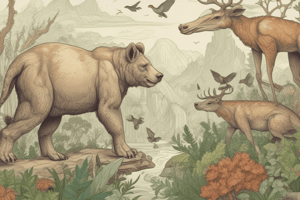Podcast
Questions and Answers
विकास की प्रक्रिया में पर्यावरण में लाभकारी लक्षण प्राप्त होते हैं और टिकाऊ प्रजाति में बदल जाते हैं
विकास की प्रक्रिया में पर्यावरण में लाभकारी लक्षण प्राप्त होते हैं और टिकाऊ प्रजाति में बदल जाते हैं
True (A)
भूगोलीय अलगाव के माध्यम से नई प्रजातियां नहीं आती हैं
भूगोलीय अलगाव के माध्यम से नई प्रजातियां नहीं आती हैं
False (B)
पारिस्थितिकी और विकास दोनों ही जीवविज्ञान के अलग-अलग पहलू हैं
पारिस्थितिकी और विकास दोनों ही जीवविज्ञान के अलग-अलग पहलू हैं
False (B)
विकास की प्रक्रिया में सिर्फ लाभकारी लक्षण ही प्राप्त होते हैं
विकास की प्रक्रिया में सिर्फ लाभकारी लक्षण ही प्राप्त होते हैं
पारिस्थितिकी और विकास के क्षेत्र में संरक्षण, कृषि और चिकित्सा में उनके अनुप्रयोग हैं
पारिस्थितिकी और विकास के क्षेत्र में संरक्षण, कृषि और चिकित्सा में उनके अनुप्रयोग हैं
Flashcards are hidden until you start studying
Study Notes
Biology: Ecology and Evolution
Ecology
Ecology is the branch of biology that studies the interactions among organisms and their environments. It encompasses various subtopics, including ecosystems, populations, and communities, and it has become increasingly important in the face of global challenges such as climate change and habitat destruction.
Ecosystems
An ecosystem consists of all living things in a particular area together with the abiotic, nonliving parts of that environment. For example, a forest ecosystem includes trees, animals, soil, and water. Understanding ecosystems helps us to better manage resources and protect the environment.
Populations and Communities
A population is all individuals within a species living within a specific area. A community is a set of populations inhabiting a particular area. Studying populations and communities allows us to understand how species interact with each other and how they are affected by changes in their environment.
Evolution
Evolution is the process of gradual change in a population that can also lead to new species arising from older species. It is a cornerstone of biology and is based on the principles of natural selection, where organisms with traits that allow them to better survive and reproduce are more likely to pass those traits on to future generations.
Natural Selection
Natural selection is the driving force behind evolution. It acts on traits that provide an advantage in the environment, increasing the likelihood that an organism will survive and reproduce. Over time, these advantageous traits become more common in the population, leading to evolutionary change.
Speciation
Speciation is the process by which new species arise from older ones. It can occur through various mechanisms, including geographic isolation, where populations become separated and evolve independently, or through the development of reproductive barriers that prevent interbreeding between populations.
Conclusion
Ecology and evolution are two interrelated aspects of biology that help us understand the natural world around us. Ecology provides insights into the interactions between organisms and their environments, while evolution explains how species change over time. Both fields are crucial for understanding the complex relationships that exist within and between different species, and they have applications in fields such as conservation, agriculture, and medicine.
Studying That Suits You
Use AI to generate personalized quizzes and flashcards to suit your learning preferences.




